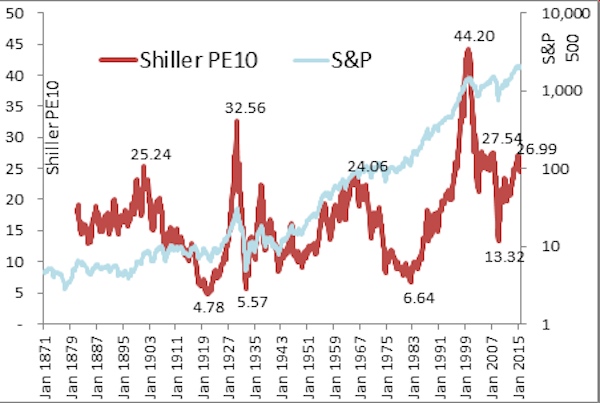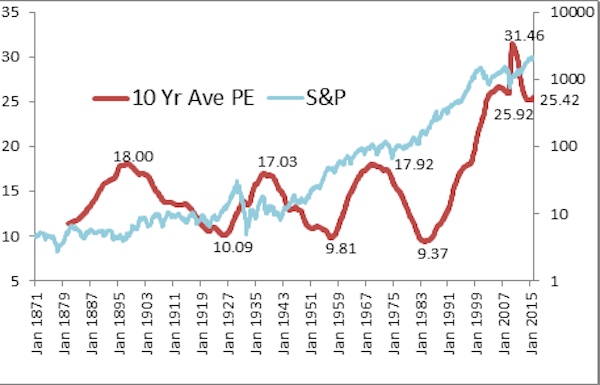I See a Major Stock Market Decline Ahead
Do not buy the hype that the market is fairly valued or undervalued. You can see for yourself in the charts below.

"Price is what you pay: value is what you get." – Warren Buffett
Investors seem to have a good handle on stock prices. This stock is $100/sh, that stock is $45/sh and so on. But do they know the value of those stocks?
Just because a stock trades for $50/sh doesn't mean its value is $50/share. The same goes for the market. Just because the S&P 500 trades at 1950, doesn't mean it is worth 1950.
From just $107.88 $24.99 for Kiplinger Personal Finance
Be a smarter, better informed investor.

Sign up for Kiplinger’s Free Newsletters
Profit and prosper with the best of expert advice on investing, taxes, retirement, personal finance and more - straight to your e-mail.
Profit and prosper with the best of expert advice - straight to your e-mail.
There are a number of ways to value a stock or a market. Price/Earnings Ratio (PE) is most often used. It tells an investor how many dollars the company earns for each share of stock they own. Suppose a company has Earnings Per Share (EPS) of $2.00 and a stock that trades at $30. Its' PE would be 15. By itself, this tells you nothing, but comparing it to the earnings growth rate may reveal if the stock price is over or under valued.
So, for example, a stock trading at $100/sh with a PE of 10 may be a better value than a stock trading at $15 with a PE of 25. Why? The $100 stock has a lower PE. Generally, lower PE's mean better value. So even though the $15 stock had a lower price, since its price to earnings ratio was so much higher, it was not as good a value.
Each stock has its own PE and EPS growth rate. They all move in cycles that may appear to be random to some. That is where markets come in. Studying the market's earnings and cycles can give an investor insights into whether the whole market is over or under valued.
The chart below shows the Shiller PE10 compared to the S&P 500. (The PE10 is a PE measurement developed by Robert Shiller. It measures the moving average of 10 years of S&P 500 earnings and applies inflation to help smooth out volatility.) While the market appears to continually go up, (it doesn't, as we all have been painfully aware since 2016 began, but more on that at another time) the PE10 has a very clear cycle. The peak PE10 in 1929 was 32.56. The peak during the Dot-com bubble was 44.20. The peak before the 2008 crash was 27.54. And what was the most recent peak (in 2015)? – 26.99. PE10s above 24 tend to be very overvalued.

Because value is cyclical, the PE10 goes up and then down. The PE10 has hit 4.78; 5.57 and 6.64 at previous value lows. PE10s under 10 would be considered very undervalued. What was the low in 2009, when the market hit a price low? 13.32 - Far from previous value lows. This is one of the main reasons we have felt that the ensuing market rally from 2009 through 2014 was artificial, based on outside influences and not based on market fundamentals or value.
Below is a simpler chart showing the rolling ten year average PE of the S&P 500. Here the cycle is much clearer, peaking in the high teens and bottoming around 9 or 10 times earnings. Until 1997.

In 1997, at about 18 PE, the chart appears to want to top out. But instead, it skyrockets higher. This is part of the so-called “Greenspan Miracle,” where former Fed Chairman Alan Greenspan discovered that pumping money into the system would pump up the market. As you can see, the red line (10 yr average PE) continued up to an all-time high of 31.46, almost double previous highs. Since then, the PE has come down, but is still well above previous highs.
So what does all of this mean to investors? In order for the composite "value" of the market to come down to its historical cyclical lows, either earnings are going to have to skyrocket or stock prices have a long way to fall. To bring stock prices down to previous historically high values, the market would have to drop another 20% or so. To come down to average valuation, the market would have to drop around 50% and to get to historically low values…. you don't want to know.
So here are the five numbers you should understand before you invest another dollar:
1) The Current PE10 is about 24 to 26.
2) Historical lows for the PE10 averaged about 5.50 (not including 2009.)
3)The 2009 low only hit 13.32, more than double the average low.
4) Peaks above 24 have always led to long term market declines.
5) The Trailing 10 year average PE at the end of 2015 was 25.42, more than 2.5 times the historical lows.
How do you use this information?
- Expect a major league market decline. It may be fast, it may be slow. It may last months, it may last years.
- Review your holdings to see if they are overvalued or not.
- Do not panic, rationally decide what to keep and what to sell.
- Do not buy the hype that the market is fairly valued or undervalued. You can see for yourself by the charts above, the market is very overvalued based on PE10 and trailing 10 year average PE.
- Sell into rallies. There will very likely be some spectacular rallies.
- Whatever you decide to keep, be prepared to see it at much lower prices.
- Prepare a shopping list of companies you would like to own at lower prices.
- Rely on your strategy. If it is tactical, let it do its work, moving you in and out of the market. If it is contrarian, stick with it, if it is Dollar Cost Averaging, the volatility may work in your favor, (if it is indexing or buy n' hold – good luck! You might want to change strategies.)
Lastly, when I first started in the business, more than 30 years ago, an old-timer told me a hard truth about the markets - that bear markets hurt as many people as much as possible. That is why they have such big rallies, to sucker people back in, and then slam them.
John Riley, registered Research Analyst and the Chief Investment Strategist at CIS, has been defending his clients from the surprises Wall Street misses since 1999.
Profit and prosper with the best of Kiplinger's advice on investing, taxes, retirement, personal finance and much more. Delivered daily. Enter your email in the box and click Sign Me Up.

In 1999, John Riley established Cornerstone Investment Services to offer investors an alternative to Wall Street. He is unique among financial advisers for having passed the Series 86 and 87 exams to become a registered Research Analyst. Since breaking free of the crowd, John has been able to manage clients' money in a way that prepares them for the trends he sees in the markets and the surprises Wall Street misses.
-
 What You Learn Becoming Your Mother's Financial Caregiver
What You Learn Becoming Your Mother's Financial CaregiverWriter and certified financial planner Beth Pinsker talks to Kiplinger about caring for her mother and her new book.
-
 I want to help pay for my grandkids' college. Should I make a lump-sum 529 plan contribution or spread funds out evenly through the years?
I want to help pay for my grandkids' college. Should I make a lump-sum 529 plan contribution or spread funds out evenly through the years?We asked a college savings professional and a financial planning expert for their advice.
-
 Seven Moves for High-Net-Worth People to Make Before End of 2025, From a Financial Planner
Seven Moves for High-Net-Worth People to Make Before End of 2025, From a Financial PlannerIt's time to focus on how they can potentially reduce their taxes, align their finances with family goals and build their financial confidence for the new year.
-
 I'm a Financial Planner: These Are the Seven Tiers of Retirement Well-Being
I'm a Financial Planner: These Are the Seven Tiers of Retirement Well-BeingLet's apply Maslow's hierarchy of needs to financial planning to create a guide for ranking financial priorities.
-
 Why More Americans Are Redefining Retirement, Just Like I Did
Why More Americans Are Redefining Retirement, Just Like I DidRetirement readiness requires more than just money. You have a lot of decisions to make about what kind of life you want to live and how to make it happen.
-
 A Compelling Case for Why Property Investing Reigns Supreme, From a Real Estate Investing Pro
A Compelling Case for Why Property Investing Reigns Supreme, From a Real Estate Investing ProInvestment data show real estate's superior risk-adjusted returns and unprecedented tax advantages through strategies like 1031 exchanges and opportunity zones.
-
 Are You Retired? Here's How to Drop the Guilt and Spend Your Nest Egg
Are You Retired? Here's How to Drop the Guilt and Spend Your Nest EggTransitioning from a lifetime of diligent saving to enjoying your wealth in retirement tends to be riddled with guilt, but it doesn't have to be that way.
-
 Government Shutdown Freezes National Flood Insurance Program: What Homeowners and Buyers Need to Know
Government Shutdown Freezes National Flood Insurance Program: What Homeowners and Buyers Need to KnowFEMA's National Flood Insurance Program is unavailable for new customers, increased coverage or renewals during the government shutdown.
-
 Separating the Pros From the Pretenders: This Is How to Tell if You Have a Great Adviser
Separating the Pros From the Pretenders: This Is How to Tell if You Have a Great AdviserDo you leave meetings with your financial adviser feeling as though you've been bulldozed into decisions or you're unsure of what you're paying for?
-
 Five Downsides of Dividend Investing for Retirees, From a Financial Planner
Five Downsides of Dividend Investing for Retirees, From a Financial PlannerCan you rely on dividend-paying stocks for retirement income? You'd have to be extremely wealthy — and even then, the downsides could be considerable.